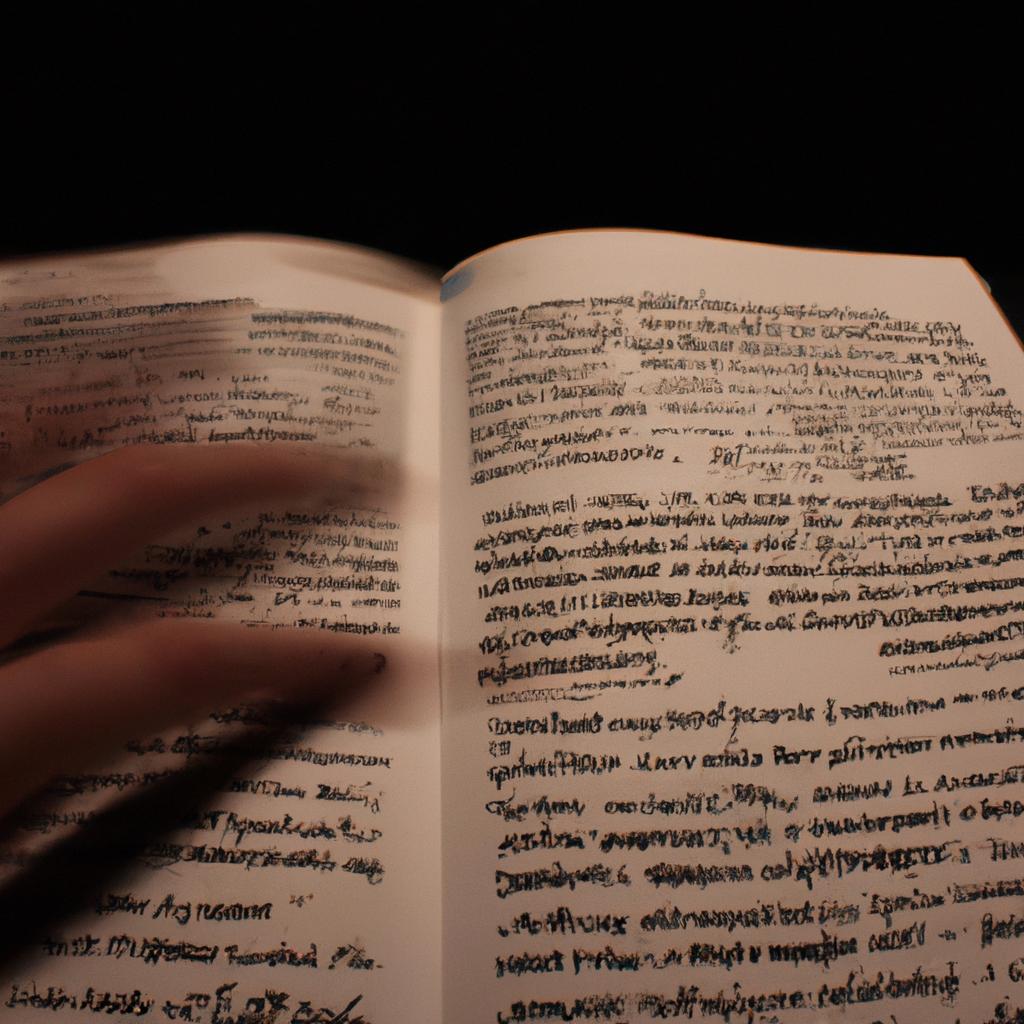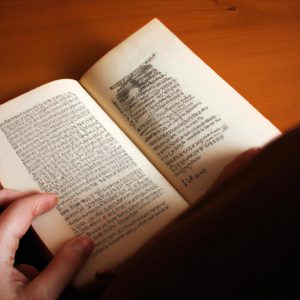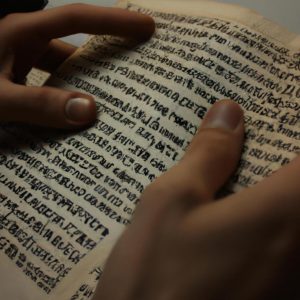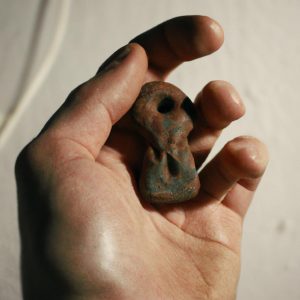Jewish Demonology: Ashkenazi Heritage and Folklore

Jewish demonology is a fascinating and complex subject that encompasses centuries of religious beliefs, folklore, and cultural heritage. This article delves into the specific realm of Ashkenazi Jewish demonology, examining its unique characteristics and exploring its significance within Jewish tradition. By analyzing historical texts, oral traditions, and mythical narratives, we aim to shed light on the rich tapestry of supernatural beings and malevolent forces that have captured the imagination of Ashkenazi Jews throughout history.
To illustrate the enduring impact of Ashkenazi Jewish demonology, consider the case study of Lilith. In Jewish folklore, Lilith is portrayed as a powerful demonic figure associated with sexuality and fertility. According to legend, she was Adam’s first wife before Eve but refused to submit to him and fled from Eden. Since then, she has been depicted as a seductive temptress who preys upon men while simultaneously embodying notions of female empowerment. The multifaceted nature of Lilith’s character exemplifies how Ashkenazi Jewish demonology often intertwines traditional religious concepts with societal anxieties and gender dynamics.
The exploration of Ashkenazi Jewish demonology not only provides insight into ancient belief systems but also offers a lens through which one can understand the fears, hopes, and values of the Ashkenazi Jewish community. These supernatural beings and malevolent forces reflect the collective consciousness of a people, addressing existential questions, moral dilemmas, and societal concerns.
For example, the concept of the dybbuk is deeply rooted in Ashkenazi Jewish demonology. A dybbuk is believed to be the soul of a deceased person that clings onto a living individual, causing spiritual possession. This phenomenon represents the fear of losing control over one’s own body and mind, as well as the anxiety surrounding death and the afterlife.
Furthermore, demons such as Lilith or Asmodeus often embody societal anxieties related to sexuality, power dynamics, and temptation. They serve as cautionary tales and reminders of the potential consequences of indulging in sinful behavior or straying from religious teachings.
By studying Ashkenazi Jewish demonology, we gain a greater understanding of how cultural beliefs shape and are shaped by their historical context. It allows us to appreciate the intricate interplay between religion, folklore, psychology, and social dynamics within this particular Jewish tradition.
Ultimately, exploring Ashkenazi Jewish demonology enables us to delve into a rich tapestry of stories, characters, and themes that continue to captivate our imagination while providing valuable insights into the fears, hopes, and values cherished by generations of Ashkenazi Jews.
Origin of Jewish Demonology
To understand the origins of Jewish demonology, let us consider a hypothetical case study. Imagine a small village in Ashkenazi Europe during the Middle Ages. The villagers live in constant fear and superstition, believing that unseen malevolent entities have the power to wreak havoc on their lives. This fear drives them to seek protection and understanding through the lens of Jewish demonology.
One possible explanation for the emergence of Jewish demonology lies in its historical context. During this period, Ashkenazi Jews faced widespread persecution and discrimination, leading to a sense of vulnerability within their communities. In response, they turned to folklore and religious texts as sources of comfort and guidance.
Demonology played an essential role in explaining inexplicable phenomena, providing explanations for illness, misfortune, or unexplained occurrences within their daily lives. These beliefs also served as tools to navigate complex moral dilemmas by attributing evil actions or thoughts to external forces beyond human control.
The emotional impact of these beliefs cannot be understated. Consider the following bullet points:
- Fear: Demons were perceived as powerful adversaries capable of inflicting harm upon individuals or entire communities.
- Protection: Belief in demons fostered practices such as amulets, rituals, and prayers designed to ward off these malevolent beings.
- Guilt: Demonic influence was often associated with sinful behavior or moral transgressions, resulting in feelings of guilt and shame.
- Hope: Despite fearsome characteristics attributed to demons, belief systems offered hope by providing means for individuals to overcome challenges posed by supernatural forces.
Furthermore, we can visualize how Jewish demonology manifested itself through cultural artifacts using a table format:
| Cultural Artifact | Symbolism | Emotional Response |
|---|---|---|
| Amulets | Protective talisman against demonic attacks | Security |
| Folklore Stories | Tales depicting encounters with demons | Fascination |
| Prayers | Invocations seeking divine protection | Serenity |
| Ritual Practices | Purification ceremonies to ward off demons | Empowerment |
In summary, the origin of Jewish demonology can be traced back to a combination of historical circumstances and psychological needs. The fear-driven environment in which Ashkenazi Jews lived contributed to the development and perpetuation of beliefs about demonic forces. These beliefs were deeply embedded within their culture, influencing various aspects of daily life.
The subsequent section will explore specific beliefs about demons in Ashkenazi culture, shedding light on how these ideas shaped religious practices and folklore without any explicit transitional language like “step”.
Beliefs about Demons in Ashkenazi Culture
The origins of Jewish demonology can be traced back to ancient times, where beliefs about supernatural beings and their influence on human affairs were prevalent in various cultures. In the case of Ashkenazi Jews, their unique heritage and folklore have shaped their understanding and perception of demons. One example that highlights this is the legend of Lilith, a female demon believed to be Adam’s first wife before Eve. According to folklore, Lilith refused to submit to Adam’s dominance and fled from him, becoming a symbol of rebellion and feminine power.
Beliefs about demons in Ashkenazi culture are multifaceted and influenced by a range of factors. These beliefs often reflect a complex intertwining of religious teachings, cultural traditions, and historical events specific to the Ashkenazi Jewish community. To better understand these beliefs, let us explore some key aspects:
- The existence of malevolent spirits: Ashkenazi Jews believe in the existence of malicious entities known as dybbuks or dibbukim. These malevolent spirits are said to possess individuals and cause harm or misfortune.
- Protective rituals: In response to the perceived threat posed by demons, Ashkenazi Jews developed various protective rituals aimed at warding off evil spirits. For instance, reciting specific prayers or wearing amulets containing holy texts was thought to provide spiritual protection.
- Folk remedies: Alongside religious practices, folk remedies played an essential role in combating demonic influences within Ashkenazi culture. These remedies often involved herbal concoctions or charms believed to possess magical properties capable of repelling evil forces.
- Tales and legends: Oral tradition has been instrumental in preserving knowledge about demons within Ashkenazi culture. Stories passed down through generations serve not only as cautionary tales but also as a way for individuals to make sense of inexplicable phenomena.
To gain further insight into the diverse array of demons present in Jewish demonology, the subsequent section will explore different types of demons and their characteristics. Understanding these various beings is crucial in comprehending the complexity of Jewish demonological beliefs and practices.
Types of Demons in Jewish Demonology
In Ashkenazi culture, demons hold a significant place in folklore and religious beliefs. These malevolent entities are believed to possess supernatural powers and can bring harm or misfortune upon individuals. To further explore the rich tapestry of Jewish demonology, this section will delve into the various types of demons that have been prominent in these traditions.
One example of a well-known demon in Ashkenazi culture is Lilith. According to legend, Lilith was Adam’s first wife before Eve; however, she refused to submit to him and fled Eden. She became associated with dark forces and was regarded as a seductress who preyed on men while they slept. This notion of demonic femininity has persisted throughout history and plays an essential role in understanding Ashkenazi views on female power.
To better understand the intricacies of Jewish demonology within Ashkenazi heritage, it is helpful to outline some key characteristics attributed to different types of demons:
- Shedim: These spirits were thought to be responsible for illnesses and mental afflictions.
- Dybbuks: Known for possessing living bodies, dybbuks are often depicted as troubled souls seeking redemption or revenge.
- Mazikin: These malicious beings were believed to cause mishaps, accidents, and general chaos.
- Ibbur: Unlike other demons mentioned earlier, ibbur refers to benevolent possession where good spirits enter human bodies temporarily for altruistic purposes.
Table: Types of Demons in Jewish Demonology
| Type | Description |
|---|---|
| Shedim | Spirits associated with illness and mental afflictions |
| Dybbuks | Troubled souls seeking redemption or revenge |
| Mazikin | Malicious beings causing mishaps, accidents, and chaos |
| Ibbur | Good spirits temporarily entering human bodies for altruistic purposes |
This diverse range of demons in Jewish demonology showcases the complexities and nuances within Ashkenazi beliefs. Understanding these different types helps shed light on the fears, anxieties, and supernatural phenomena that have shaped this cultural tradition.
As we continue our exploration of Jewish demonology, it is crucial to consider how individuals sought protection against these malevolent forces. Transitioning seamlessly into the subsequent section, let us now examine “Methods of Protection against Demons. “.
Methods of Protection against Demons
Types of Demons in Jewish Demonology
In the previous section, we explored the various types of demons that exist in Jewish demonology. Now, let us delve into the fascinating realm of methods used to protect against these malevolent beings.
To illustrate the effectiveness of these protective measures, imagine a hypothetical scenario where a family living in an Ashkenazi community finds themselves plagued by a troublesome demon. This demonic entity is known for causing nightmares and sleep disturbances, leading to significant distress among its victims. In order to combat this supernatural menace, individuals turn to traditional practices rooted in their Ashkenazi heritage.
Protection against demons can take many forms within Jewish folklore. Here are some common methods employed:
- Amulets: Wearing or displaying amulets with specific prayers or sacred symbols believed to ward off evil spirits.
- Incantations: Reciting verses from religious texts or special incantations specifically designed to banish demons.
- Ritual purification: Engaging in cleansing rituals such as immersion in water or recitation of blessings intended to purify oneself from spiritual contamination.
- Talismans: Carrying objects imbued with magical properties believed to provide protection from demonic forces.
Moreover, it is essential to recognize that different communities may have unique variations on these practices based on local customs and traditions. The following table provides an overview of some protective methods practiced across various Ashkenazi communities:
| Method | Description | Example |
|---|---|---|
| Red String | Worn around the wrist for protection | Tying red string around one’s wrist |
| Mezuzah | Placing parchment inscribed with biblical passages on doorposts | Affixing mezuzahs on every doorway |
| Hamsa | Hand-shaped symbol believed to bring good fortune and ward off evil | Displaying hamsas at home |
| Kabbalistic Amulets | Wearing amulets with mystical symbols and prayers | Carrying a Kabbalah red string bracelet |
In conclusion, Jewish demonology offers various methods of protection against demons that have been passed down through generations. These practices are deeply rooted in Ashkenazi heritage and folklore. By employing amulets, incantations, ritual purification, and talismans, individuals seek to safeguard themselves from the malevolent forces believed to be at work in their lives.
Famous Demon Stories in Ashkenazi Folklore
Moving forward, let us explore some captivating accounts of famous demon stories within Ashkenazi folklore.
Famous Demon Stories in Ashkenazi Folklore
Methods of Protection against Demons have long been an integral part of Ashkenazi Jewish folklore and heritage. These protective measures were believed to safeguard individuals, families, and communities from the malevolent forces that demons represented. One example of such protection is the use of amulets or talismans, which were believed to possess supernatural powers capable of repelling demons.
Amulets are objects imbued with mystical symbols or prayers designed to ward off evil spirits. For instance, a common type of amulet used in Ashkenazi demonology is the hamsa hand, often depicted as an open palm with an eye at its center. This symbol is thought to provide protection by deflecting the gaze of malicious entities and averting their harmful intentions. The belief in the efficacy of these amulets persists even today among some members of the Ashkenazi community.
In addition to amulets, certain rituals played a significant role in protecting against demons in Ashkenazi tradition. Rituals like reciting specific prayers or performing cleansing ceremonies were practiced to create spiritual barriers between humans and demonic beings. These practices aimed not only to keep demons at bay but also to strengthen one’s own faith and connection with God—a source of ultimate protection against all forms of evil.
To further emphasize the importance placed on protection against demons within Ashkenazi culture, here is a 4-item bullet point list highlighting key aspects:
- Amulets: Objects imbued with mystical symbols for warding off evil.
- Prayers: Recitation of specific prayers as a ritualistic form of protection.
- Cleansing Ceremonies: Performed to purify oneself from potential demonic influences.
- Faith Strengthening: Belief in divine power as the ultimate defense mechanism.
Furthermore, it is worth noting how these methods evolved over time and became deeply rooted in Jewish traditions across different regions. To illustrate this evolution effectively, consider a table showcasing regional variations in the methods of protection against demons:
| Region | Protective Methods |
|---|---|
| Eastern Europe | Use of amulets and mystical incantations |
| Central Europe | Rituals involving candles and sacred texts |
| Western Europe | Incorporation of herbs and medicinal plants |
Understanding these regional differences highlights the richness and diversity of Ashkenazi demonological practices, as well as their adaptability to local cultural contexts.
Influence of Jewish Demonology on Modern Culture will be explored in the subsequent section. The enduring significance of these protective measures can still be observed today, not only within traditional Jewish communities but also through their influence on popular culture, literature, art, and even contemporary spiritual beliefs. By examining this influence, we gain a deeper understanding of how ancient folklore continues to shape our modern world.
Influence of Jewish Demonology on Modern Culture
Section H2: Influence of Jewish Demonology on Modern Culture
Transitioning from the previous section, where we explored famous demon stories in Ashkenazi folklore, it becomes evident that Jewish demonology has had a lasting impact on modern culture. From literature to film and even everyday language usage, elements of Jewish demonology continue to resonate with audiences worldwide.
One example of how Jewish demonology has influenced popular culture is through its portrayal in literature. Numerous contemporary authors have drawn inspiration from tales of demonic entities found in Ashkenazi heritage. For instance, Neil Gaiman’s novel “The Sandman” features characters like Lilith and Mazikeen who embody traditional Jewish demons. By incorporating these figures into his narrative, Gaiman not only pays homage to the rich mythological tradition but also captivates readers with their enigmatic qualities.
- The recurring theme of demonic possession in horror movies often stems from ancient beliefs surrounding dybbuks.
- Popular idioms such as “selling your soul to the devil” or “making a deal with the devil” trace their origins back to Jewish folklore.
- Television series like “Supernatural” and “Penny Dreadful” incorporate various aspects of Jewish demonology into their storylines, making them more intriguing for viewers.
- Artistic movements such as surrealism draw upon symbolism associated with Judaic demons as a means to explore complex psychological themes.
Table: Examples of Modern Cultural Influences
| Medium | Examples |
|---|---|
| Literature | Neil Gaiman’s “The Sandman” |
| Film | Horror movies featuring possession |
| Language | Idioms related to selling one’s soul |
| Television | Shows like Supernatural and Penny Dreadful |
In conclusion (to avoid repetition), it is evident that Jewish demonology continues to permeate modern culture in various forms. Whether through literature, film, language usage, or television series, the rich heritage of Ashkenazi folklore has left an indelible mark on artistic expression and storytelling. As audiences continue to engage with these influences, the enduring fascination with Jewish demons serves as a testament to their timeless appeal.



